
The geometer moths are moths belonging to the family Geometridae of the insect order Lepidoptera, the moths and butterflies. Their scientific name derives from the Ancient Greek geo γεω, and metron μέτρον "measure" in reference to the way their larvae, or inchworms, appear to measure the earth as they move along in a looping fashion. Geometridae is a very large family, containing around 23,000 described species; over 1400 species from six subfamilies are indigenous to North America alone. A well-known member is the peppered moth, Biston betularia, which has been the subject of numerous studies in population genetics. Several other geometer moths are notorious pests.

The common emerald is a moth of the family Geometridae. The species is found throughout the Nearctic and Palearctic regions and the Near East. It is mostly commonly found in the southern half of the Ireland and Britain. It was accidentally introduced into southern British Columbia in 1973.
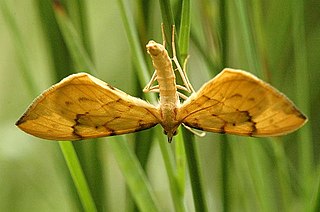
The barred straw is a moth of the family Geometridae. The species was first described by Michael Denis and Ignaz Schiffermüller in 1775. It is sometimes placed in the genus Gandaritis. It is found throughout the Palearctic region, including Britain and Ireland, and also the Near East.

The November moth is a moth of the family Geometridae. The species was first described by Michael Denis and Ignaz Schiffermüller in 1775. It can be found in the Palearctic realm in western Europe from central Scandinavia to the Mediterranean the Caucasus and western Russia.

The pale November moth is a moth of the family Geometridae. The species was first described by Allen in 1906. It is a fairly common species in Western Europe including the British Isles.

The scalloped oak is a moth of the family Geometridae. The species was first described by Carl Linnaeus in his 1758 10th edition of Systema Naturae.

The mottled umber is a moth of the family Geometridae. It is common throughout much of the Palearctic region. The species was first described by Carl Alexander Clerck in 1759.

Campaea margaritata, commonly known in the UK as the light emerald, is a moth of the family Geometridae. The species was first described by Carl Linnaeus in his 1767 12th edition of Systema Naturae. It is widely distributed throughout Europe, the Near East and North Africa. The habitat is mixed forests including parks and large gardens.

Chloroclysta siterata, the red-green carpet, is a moth in the family Geometridae. The species was first described by Johann Siegfried Hufnagel in 1767.
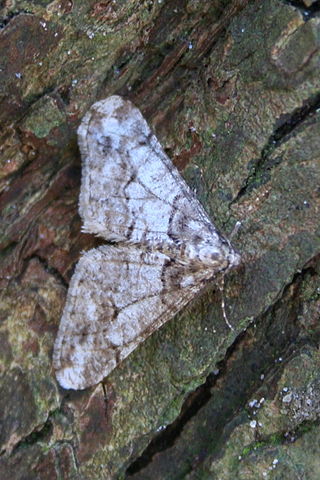
Agriopis leucophaearia, the spring usher, is a moth of the family Geometridae. The species was first described by Michael Denis and Ignaz Schiffermüller in 1775. It is a Palearctic species found from Europe, Turkey and Regions of the Russian Federation: the Volga-Don, East Caucasus, the European Central Black Earth, Central European, European southern taiga, the Western Caucasus, Kaliningrad, Mid-Volzhsky., mainly in oak forests and in heathland with low-growing oaks.
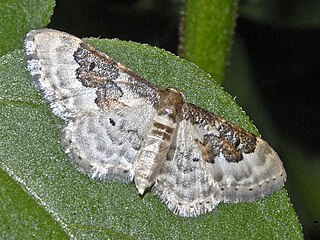
Idaea rusticata, the least carpet, is a moth of the family Geometridae. The species was first described by Michael Denis and Ignaz Schiffermüller in 1775.

Ecliptopera silaceata, the small phoenix, is a species of moth in the family Geometridae. The species was first described by Michael Denis and Ignaz Schiffermüller in 1775.

Lomographa temerata, the clouded silver, is a moth of the family Geometridae. The species is found in Asia and Europe and was first described by Michael Denis and Ignaz Schiffermüller in 1775.

Entephria caesiata, the grey mountain carpet, is a moth of the family Geometridae. The species was first described by Michael Denis and Ignaz Schiffermüller in 1775. It is found in the mountainous areas of Europe, the Caucasus, Asia Minor, Armenia, Russia, Russian Far East, Siberia, northern Mongolia, Sakhalin and Honshū in Japan.

Cleora cinctaria, the ringed carpet, is a moth of the family Geometridae. The species was first described by Michael Denis and Ignaz Schiffermüller in 1775. It is found from Europe to southern Siberia, Turkey, the Caucasus, central Asia and Mongolia. It is also found in Japan.
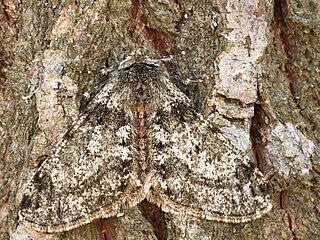
Phigalia pilosaria, the pale brindled beauty, is a moth of the family Geometridae. The species was first described by Michael Denis and Ignaz Schiffermüller in 1775. It is found from Europe and Anatolia to the Caucasus.

Earophila badiata, the shoulder stripe, is a moth of the family Geometridae. The species was first described by Michael Denis and Ignaz Schiffermüller in 1775. It is found from most of Europe and North Africa to the Altai Mountains in the east Palearctic.

Colostygia olivata, the beech-green carpet, is a moth of the family Geometridae. It was first described by Michael Denis and Ignaz Schiffermüller in 1775 and it is found in most of the Palearctic.
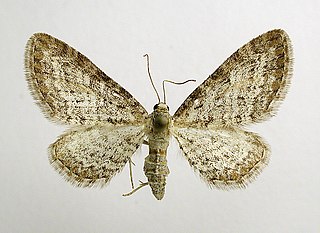
Eupithecia subumbrata, the shaded pug, is a moth of the family Geometridae. The species was first described by Michael Denis and Ignaz Schiffermüller in 1775. It is found from Mongolia and the Altai Mountains through Siberia, central Asia, Asia Minor and Russia to western Europe and from central Scandinavia to the Mediterranean region.

Gnophos obfuscata, commonly known as the Scotch annulet or Scottish annulet, is a moth of the family Geometridae. The species was first described by Michael Denis and Ignaz Schiffermüller in 1775. It can be found in northern, central, and southeastern Europe, as well as in Scotland, Ireland, and the Iberian Peninsula.
Feizpour, Shamsi, et al. “Alsophila Aescularia (Denis & Schiffermüller, 1775) a Genus and Species New to the Fauna of Iran, a Species from a Threatened Habitat.” SPIXIANA, vol. 41, no. 1, Oct. 2018, pp. 111–115. Web of Science, doi:0341-8391.






















